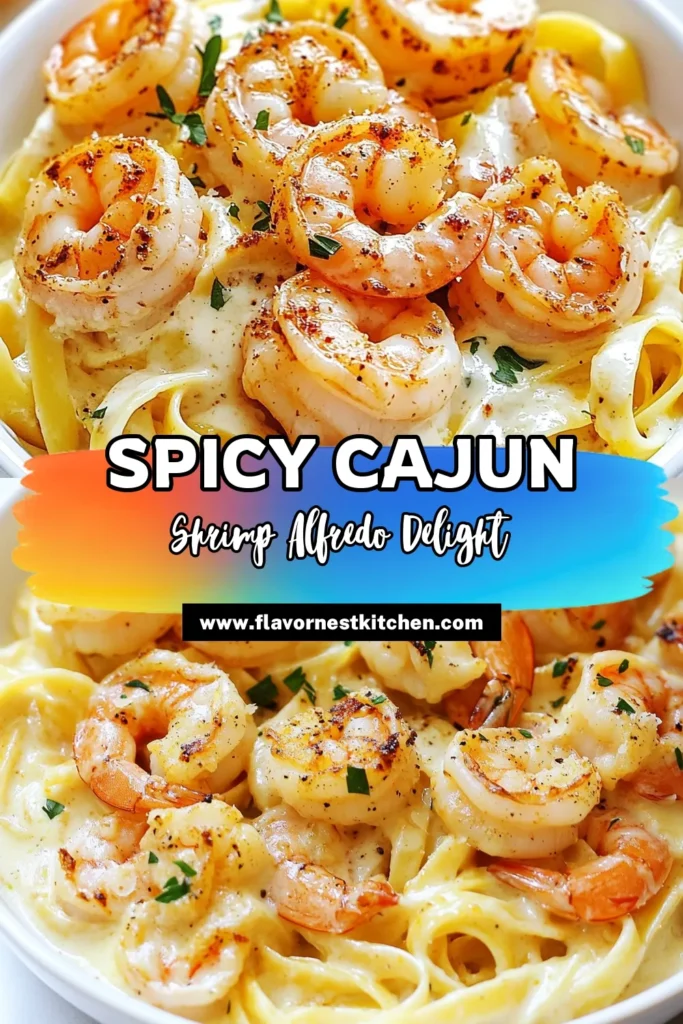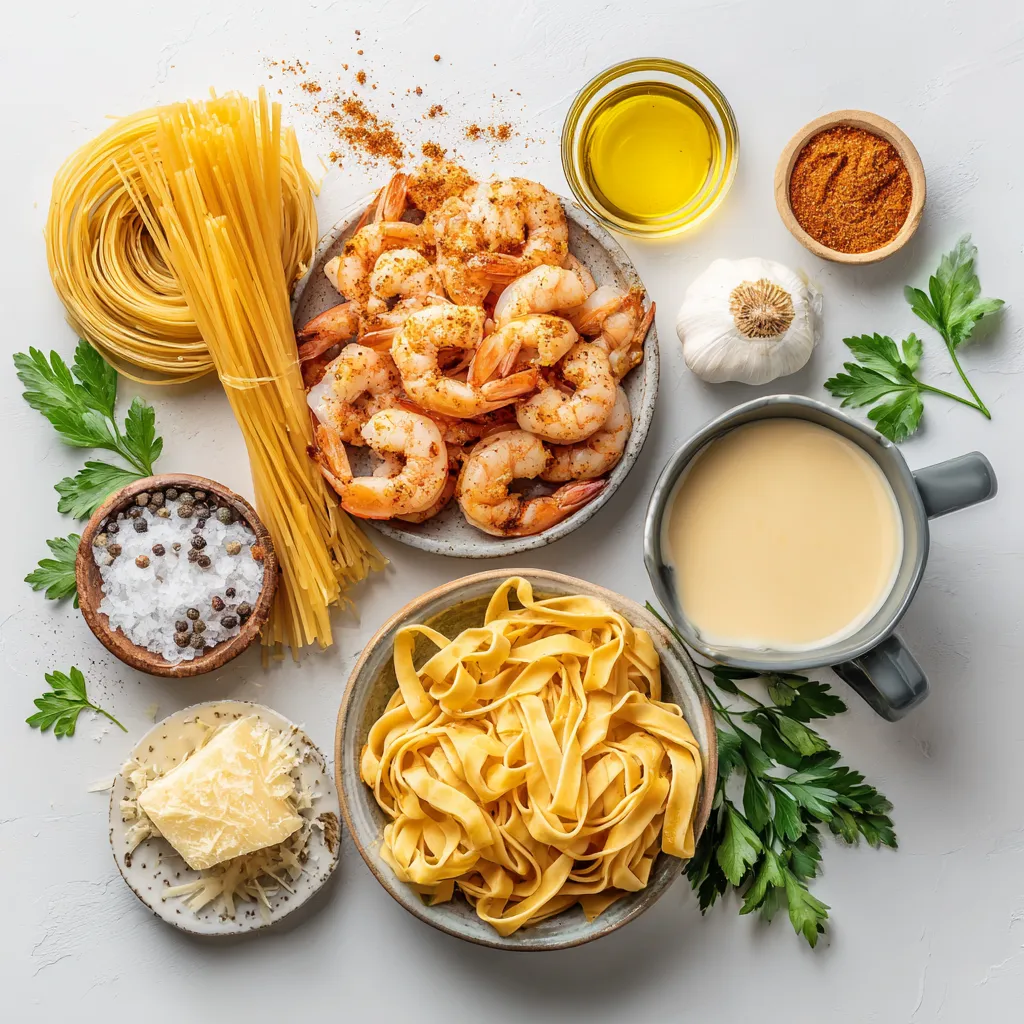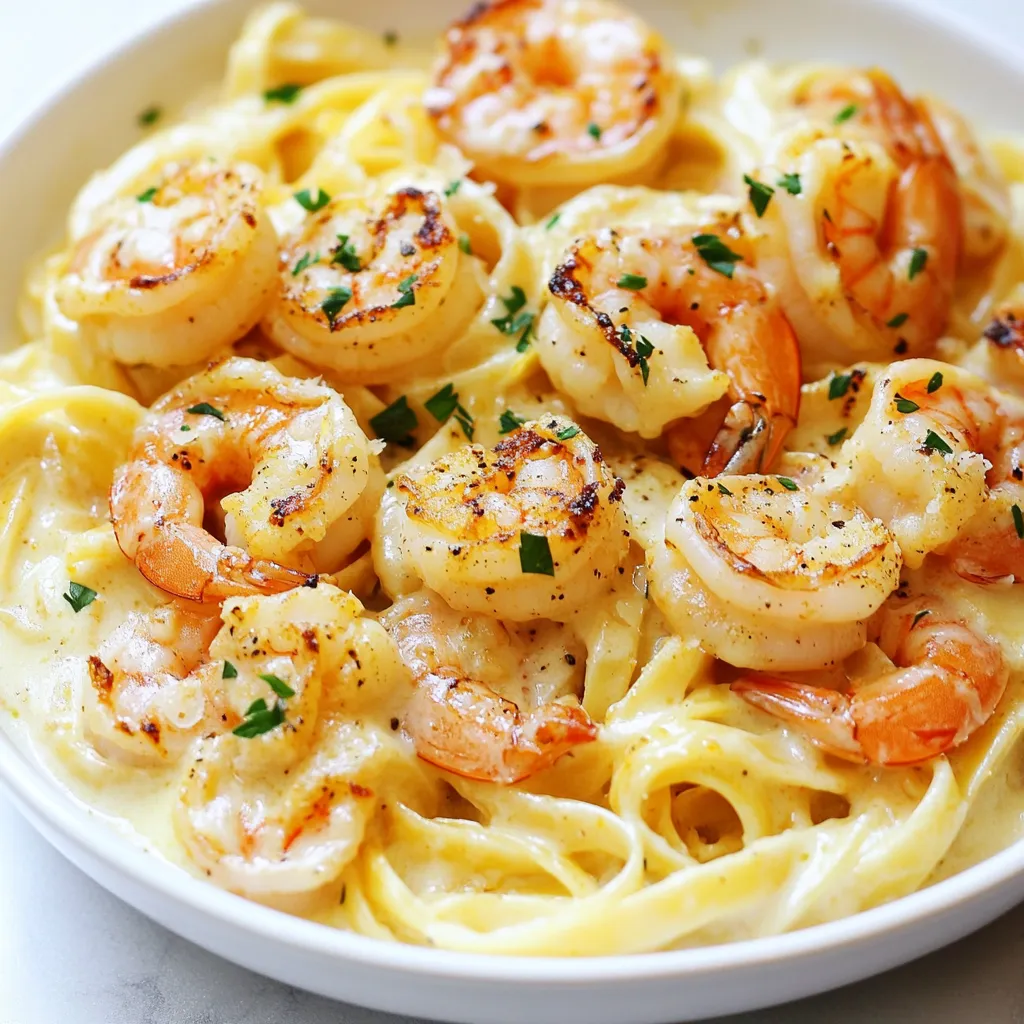WANT TO SAVE THIS RECIPE?
Are you ready for a mouthwatering dish that combines creamy goodness with a spicy kick? This Cajun Shrimp Alfredo recipe is not just simple; it’s bursting with flavor that will make your taste buds dance. You’ll learn how to create a rich sauce, perfectly cooked shrimp, and tender pasta, all in a few easy steps. Grab your ingredients, and let’s dive into this delicious meal that everyone will love!

Why I Love This Recipe
- Bold Flavors: This dish combines the richness of Alfredo sauce with zesty Cajun spices, creating a delightful flavor explosion.
- Quick & Easy: Ready in just 30 minutes, this recipe is perfect for a weeknight dinner without sacrificing taste.
- Perfectly Creamy: The heavy cream and Parmesan cheese create a luscious sauce that clings beautifully to the fettuccine.
- Customizable: Feel free to add vegetables or adjust the spice level to suit your taste preferences.
Ingredients
List of Required Ingredients
– 12 oz fettuccine pasta
– 1 lb large shrimp, peeled and deveined
– 2 tablespoons Cajun seasoning
– 3 tablespoons olive oil
– 2 cloves garlic, minced
– 1 cup heavy cream
– 1 cup grated Parmesan cheese
– 1/2 cup chicken broth
– Salt and pepper to taste
– Fresh parsley, chopped for garnish
To create a tasty Cajun Shrimp Alfredo, gather the right ingredients. Start with 12 ounces of fettuccine pasta for a hearty base. You need one pound of large shrimp, already peeled and deveined. The Cajun seasoning brings heat and flavor, so use two tablespoons. For cooking, have three tablespoons of olive oil ready.
You will also need two cloves of minced garlic to add depth. One cup of heavy cream makes the sauce rich. One cup of grated Parmesan cheese adds creaminess and a cheesy kick. A half cup of chicken broth helps to balance the sauce. Finally, season with salt and pepper to taste. Garnish your dish with fresh parsley for a pop of color and freshness.
With these ingredients, you will make a dish that is both simple and flavorful. Each component plays an important role, making every bite delicious. Enjoy the process of gathering these items. The right ingredients will set the stage for a fantastic meal!

Step-by-Step Instructions
Cooking the Pasta
– First, fill a large pot with water. Add a generous amount of salt.
– Bring the water to a full boil. This step is key for flavor.
– Add 12 oz of fettuccine pasta. Cook it until al dente, usually 8-10 minutes.
– Once cooked, drain the pasta. Reserve 1/2 cup of the pasta water for later.
Preparing the Shrimp
– In a medium bowl, take 1 lb of shrimp. Make sure they are peeled and deveined.
– Toss the shrimp with 2 tablespoons of Cajun seasoning. Coat them well.
– Heat 2 tablespoons of olive oil in a large skillet over medium-high heat.
– Add the seasoned shrimp. Sauté for about 2-3 minutes on each side.
– Cook until shrimp turn pink and opaque. Remove them from the skillet and set aside.
Making the Sauce
– In the same skillet, add another tablespoon of olive oil.
– Toss in 2 cloves of minced garlic. Sauté for 30 seconds until fragrant.
– Pour in 1/2 cup of chicken broth and 1 cup of heavy cream. Stir well to combine.
– Bring this mixture to a simmer for about 2-3 minutes.
– Gradually whisk in 1 cup of grated Parmesan cheese. Let it melt to form a smooth sauce.
– If the sauce seems too thick, add reserved pasta water a little at a time.
Combining Everything
– Add the cooked fettuccine and the sautéed shrimp back into the skillet.
– Toss everything together until the pasta and shrimp are well coated with the sauce.
– Taste and adjust the seasoning with salt and pepper as needed.
Tips & Tricks
Cooking Tips
To get the perfect shrimp texture, start with large shrimp. They cook quickly and stay juicy. When seasoning, coat the shrimp well with Cajun seasoning. This brings out their flavor. Sauté shrimp for just 2-3 minutes per side. Watch for them to turn pink and opaque. This means they are done.
If your sauce is too thick, don’t worry! Use the reserved pasta water to adjust the consistency. Add a little at a time until you reach your desired creaminess. The sauce should coat the pasta without being too heavy.
Presentation Tips
For visual appeal, serve Cajun Shrimp Alfredo in shallow bowls. The wide surface shows off the colorful dish. Sprinkle fresh parsley on top for a pop of green. This adds freshness and looks nice.
You can also add an extra sprinkle of Parmesan. It enhances the flavors and makes the dish feel special. Consider serving with a slice of garlic bread or a simple salad on the side. These make a great balance to the rich pasta.
Pro Tips
- Perfectly Cooked Pasta: Always cook your pasta al dente for the best texture. It should have a slight bite to it that complements the creamy sauce.
- Shrimp Searing: Ensure your skillet is hot enough before adding the shrimp. This will give them a nice sear and enhance their flavor.
- Cheese Quality Matters: Use freshly grated Parmesan cheese instead of pre-grated versions for a creamier sauce. The flavor and texture are significantly better.
- Adjusting Sauce Consistency: If your sauce is too thick, add the reserved pasta water gradually. This not only thins the sauce but also helps it adhere to the pasta.

Variations
Ingredient Swaps
You can swap the fettuccine for other pasta types. Penne or linguine works well too. If you want a fun twist, try using whole wheat or zucchini noodles.
For proteins, shrimp is great, but chicken or sausage also shines in this dish. You can use grilled chicken for a lighter option. Andouille sausage adds a nice Cajun kick.
Flavor Enhancements
Add vegetables to boost flavor and nutrition. Spinach wilts nicely into the sauce. Bell peppers add sweetness and color. You can sauté them with the shrimp for a tasty mix.
Experiment with spice blends for different heat levels. You can use smoked paprika for a smoky flavor. Or try cayenne pepper to kick it up a notch.
Dietary Modifications
Want a lighter version? Swap heavy cream for half-and-half or Greek yogurt. This keeps that creamy texture but cuts the fat.
If you’re gluten-free, choose gluten-free pasta. Many brands make great alternatives that taste good. Look for options made from brown rice or chickpeas for added nutrition.
Storage Info
Storing Leftovers
To keep your Cajun Shrimp Alfredo fresh, store it in the fridge. Use an airtight container. This will help keep moisture in and flavors strong. If stored well, it lasts for up to three days. Make sure to let it cool to room temperature before sealing.
Reheating Instructions
Reheating pasta can be tricky. You want to keep it tasty and creamy. I find the best way is to use the stove. Place the pasta in a skillet over low heat. Add a splash of chicken broth or water to help it heat evenly. Stir often to avoid sticking. This way, you keep the pasta smooth and creamy. You can also use the microwave. Just cover the dish and add a bit of liquid. Heat in short bursts, stirring in between. This keeps the sauce from drying out. Enjoy your delicious leftovers!
FAQs
What can I substitute for heavy cream in Cajun Shrimp Alfredo?
You can use half-and-half or whole milk. They will make the sauce thinner. If you want a richer taste, try using cream cheese or sour cream. These options will also add some tang and creaminess.
Can I make this dish ahead of time?
Yes, you can prep a few parts in advance. Cook the pasta and shrimp separately, then store them. Keep them in the fridge for up to two days. When you are ready, warm the shrimp and pasta in the sauce. This keeps everything fresh and tasty.
How spicy is Cajun Shrimp Alfredo?
The spice comes from the Cajun seasoning. It can vary by brand. Usually, it has a nice kick but is not too hot. If you like more heat, add extra seasoning or some hot sauce. Adjust it to your taste!
What sides pair well with Cajun Shrimp Alfredo?
Great sides include garlic bread or a fresh salad. You could also serve roasted vegetables or steamed broccoli. These sides balance the rich flavors of the dish and keep your meal light.
This blog post covers how to make a tasty Cajun Shrimp Alfredo. You learned about the key ingredients and their roles in the dish. We reviewed clear step-by-step instructions, cooking tips, and creative variations to suit your taste.
Try these ideas to make this dish your own. With simple swaps, you can adjust flavors or make it lighter. Enjoy making this creamy pasta dish, and share your results with others! Cooking can be fun, so dive in and savor every bit
Cajun Shrimp Alfredo
A creamy and spicy pasta dish featuring shrimp and Cajun flavors.
Prep Time 10 minutes mins
Cook Time 20 minutes mins
Total Time 30 minutes mins
Course Main Course
Cuisine Cajun
Servings 4
Calories 600 kcal
- 12 oz fettuccine pasta
- 1 lb large shrimp, peeled and deveined
- 2 tablespoons Cajun seasoning
- 3 tablespoons olive oil
- 2 cloves garlic, minced
- 1 cup heavy cream
- 1 cup grated Parmesan cheese
- 1/2 cup chicken broth
- to taste Salt and pepper
- for garnish Fresh parsley, chopped
In a large pot, bring salted water to a boil. Add fettuccine pasta and cook according to package instructions until al dente. Drain and set aside, reserving 1/2 cup of pasta water.
In a medium bowl, toss the shrimp with Cajun seasoning until well coated.
In a large skillet over medium-high heat, heat 2 tablespoons of olive oil. Add seasoned shrimp and sauté for about 2-3 minutes per side, or until they turn pink and opaque. Remove shrimp from the skillet and set aside.
In the same skillet, add the remaining tablespoon of olive oil and minced garlic. Sauté for 30 seconds until fragrant. Pour in the chicken broth and heavy cream, stirring well to combine. Bring the mixture to a simmer.
Gradually whisk in the Parmesan cheese, allowing it to melt and create a smooth sauce. If the sauce is too thick, add some reserved pasta water until desired consistency is reached.
Add the cooked fettuccine and sautéed shrimp to the sauce, tossing everything together until well coated. Season with salt and pepper to taste.
Remove from heat and let it sit for a minute to thicken slightly.
Serve in shallow bowls, garnished with chopped parsley and extra Parmesan.
Keyword Alfredo, cajun, pasta, shrimp
WANT TO SAVE THIS RECIPE?





